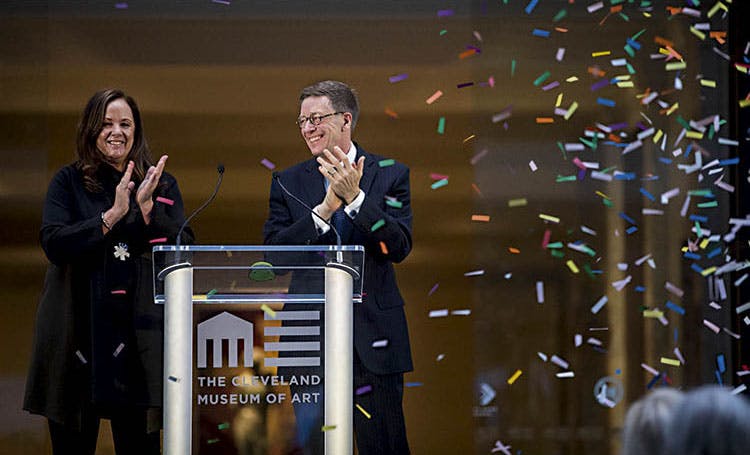- Magazine Article
- Digital Innovation
Introducing Open Access
The museums' mission to provide transformative art experiences "for the benefit of all the people forever" enters the digital age

Livestreamed Launch Jane Alexander and Bill Griswold celebrate the announcement of Open Access. Photo by Scott Shaw.
“The Cleveland Museum of Art’s adoption of a clear open-access policy allows Wikimedia volunteers alongside other reusers to build more free knowledge with its collections, and to help give these the broadest possible impact.” –Ben Vershbow, director of community programs, Wikimedia Foundation
What is Open Access?
In short, high-resolution images of about 30,000 public-domain artworks in the museum collection are now free for anyone to use without restriction, under the shared license designation Creative Commons Zero (CC0). In addition, data relevant to all 60,000 works in the collection—whether the work itself is in the public domain or is under copyright—are also universally available. The museum announced the initiative at a livestreamed event on January 23.
That morning, director William Griswold celebrated this outgrowth of the CMA’s inclusive mission: “Whenever, wherever, and however the public wishes to use, reuse, remix, or reinvent the objects that we hold, our collection is available—for we are but caretakers of these objects, which belong to the artistic legacy of humankind.”
What are the key aspects?
Open Access offers a complete and accessible digital package. The website collection pages now display more than 35 fields of metadata, including descriptive text and provenance. Publishing descriptive text with Open Access creates more possibilities for contextual interpretations related to artworks in the collection, and the provision of high-resolution images enables a greater range of uses for scholarly, commercial, and noncommercial purposes. The redesigned web interface allows visitors to choose the view that is best for them, whether that be text heavy or image focused. A refined advanced search makes finding artwork simple and intuitive by allowing users to search by fields such as provenance, exhibition history, and catalogue raisonné. The collection search background is white and features an elastic search that improves the accuracy of search outcomes, including the ability to easily sort results. An auto-complete search bar proposes potential searches and suggests correct spellings.
Downloading images is easy. On any Collection Online artwork page, select the download button directly under the artwork’s location. If the work is available through Open Access, you will see options to save both jpeg and TIFF formats in addition to the artwork’s metadata. Images notated with a copyright icon are not downloadable; however, all the valuable metadata are still available.
We have also created a well-documented, public API and a GitHub repository to allow data scientists to incorporate our collection into their data visualization. The data tools can be used by companies seeking to make improvements in artificial intelligence and machine learning as complex training sets that could in the future yield more relevant and resonant information for the public.
What does this mean for the collection?
The CMA provided early access to several local, national, and international content partners, who created projects to demonstrate the benefits of Open Access while increasing understanding and spreading access and impact to the public. Collaborators come from the worlds of art, academia, commerce, community, and technology. Wikimedia, Internet Archive, Artstor, Creative Commons, and Artsy have uploaded the CMA’s Open Access collection to their respective websites for their users to explore, reaching thousands of new users all over the world. Case Western Reserve University’s Kelvin Smith Library’s Center for Digital Scholarship will provide faculty and students with classes and consultations on how to use methods and tools (such as data analytics, Geographic Information Systems [GIS], and visualization) to conduct big data research using the images and to transform learning in a range of disciplines.
We encourage the public to download and use these images as a way of expanding the world’s relationship with our collection. Admission to the Cleveland Museum of Art has long been free of charge. Now, thanks to Open Access, our collection is more accessible than ever.
This initiative was a cross-departmental, collaborative project with representatives from curatorial, collections, interpretation, design, and digital innovation and technology services.
What is CC0?
CC0 is a legal toolset that enables institutions to share content freely, without attribution or restriction and with no rights reserve; it is the un-license. To learn more, visit creativecommons.org.
Cleveland Art, March/April 2019